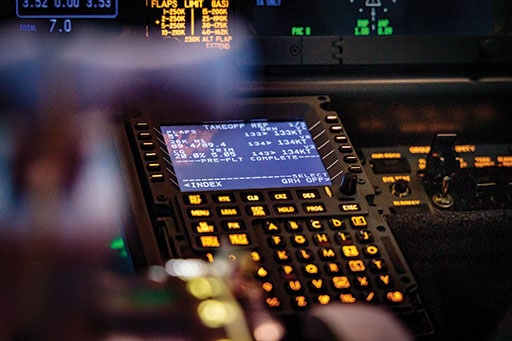In part one of our look at the status of CNS/ATM modernization efforts, Mario Pierobon explores the evolution of the diverse components that come together to make flying safer, more efficient and less impactful to the environment and to learn about what is coming next.
In the domain of air traffic management (ATM), communication, navigation, and surveillance (CNS) infrastructure provides the foundation for the provision of air navigation services. CNS infrastructure includes various on-board, ground-based, and space-based components, that are subject to technological evolution, very much like the whole ATM concept is subject to evolution. In this first part of a multi-part story on CNS technology we shall concentrate on how the traditional CNS infrastructure has developed since the early days, where the technology is headed, and the main drivers of the changes in CNS technology.
ATM Modernization
Indeed, CNS infrastructure has developed significantly since the early days of aviation. “For oceanic flights, we have moved from CNS being driven by flight engineers who would perform navigation manually using paper charts and report the position of the aircraft through voice contact with high frequency radios, to augmented GPS systems built into aircraft automatically reporting their position and routes using satellite communications. This digitalization has taken 20 years to develop to a point that it is now mandated across the most important routes around the globe.” says Ghislain Nicolle, vice president of air traffic services at Inmarsat.

According to Christine Berg, head of the Single European Sky Unit at the Directorate General for Mobility and Transport of European Commission, the various CNS systems enable airspace capacity and efficiency, and they can also contribute to environmental sustainability. “We should keep in mind that the CNS infrastructure does not deliver operational benefits directly; it is a technical enabler for providing operational benefits to ATM and airspace users,” she says. “CNS infrastructure, including both deployment of new CNS systems and rationalization of some legacy CNS systems, must evolve to achieve the long-term objective of ATM modernization — the Digital European Sky — as defined in the European ATM Master Plan in our case.”

In practical terms, the evolution of CNS systems means that there will be progressively more integrated, secure and performance-based CNS services making use of more satellite-based solutions, as well as an improved exchange of information between aircraft and the ground, according to Berg. “A unique opportunity has emerged, because of the economic impact of the COVID-19 crisis, to accelerate the rationalization of CNS infrastructure, benefitting from the decisions of some airlines to no longer operate certain aircraft types,” she points out.
In the context of the Single European Sky (SES) regulatory framework, CNS infrastructure should be managed, modernized, and operated to support the achievement of Union-wide performance, in terms of reduced environmental impact, cost-efficiency, network capacity and safety for all citizens,” according to Berg. It should enable the implementation of cross-border and pan-European service delivery models, and respect security and defence requirements,” she says.
Inmarsat is currently working in partnership with the European Space Agency (ESA) on the Iris program to develop a solution of air traffic management over the continental airspace, points out Nicolle. “Iris will deliver new communications capabilities enabling both enhanced air traffic services as well as better communications with the airline’s operation center,” he says. “This will not only improve airspace usage to accommodate future growth but will also allow airlines to fly shorter and more efficient routes, minimize flights delays, save fuel and reduce the carbon footprint of their operations. It really is a great example of the vast benefits the new area of digitized aviation can bring to aviation travel.”
Evolution of Communication Technology
Historically, the need to improve CNS emerged as a result of congested skies, expanding aircraft operations and airspace security concerns, observes Coleen Hawrysko, CANSO’s Operations Program manager. “From the advent of two-way radio communications and radio navigation beacon systems in the first part of the 20th century, pilots now communicate with air traffic control and their operation centres utilizing any of several systems – very high frequency (VHF), ultra-high frequency (UHF), and high frequency (HF) voice communications, as well as digital communications utilizing data link and satellite voice,” says Hawrysko.

The transition from voice to digital message had already begun with the introduction of controller pilot datalink communication (CPDLC), emphasizes Ruben Flohr, expert in ATM architecture and systems engineering at SESAR Joint Undertaking. “In the long term, a further shift is expected that will enable the transformation from single voice-based ATC instructions to trajectory-based operations (TBO) that build on closed-loop control whereby a ‘complex’ clearance is uplinked over datalink composed of geo-positions, time, altitude, speed and heading instructions,” he says. “The updated flight path, incorporating the complex clearance, is then downlinked through the extended projected profile (EPP) to confirm to the air traffic controller (ATCO) that the flight management system (FMS) has accepted the complex clearance. This will increase the predictability of the flight’s trajectory both for the pilot and the ATCO, and hence enable more fuel and climate efficient conflict avoidance.”

Drive Towards GNSS
In the very early days of aviation, a pilot navigated by looking out of the cockpit window, following a coastline, a river, roads and recognizing landmarks like lighthouses and church towers, observes Flohr. “The early navigation from the outside view only, was clearly fully dependent on visibility, and to mitigate this dependency, beacons were installed. Different technologies arose, like the VHF omnidirectional radio range (VOR) to enable the aircraft to measure its angle from such a beacon, and the distance measuring equipment (DME) to enable the aircraft to measure its distance from such a beacon. On-board systems would combine multiple beacons to determine the aircraft position. Complementary to the beacons, the inertial navigation system (INS) was introduced,” he says.
Since the 1980s a new mode of navigation became available which was based on a position signal from space: the global positioning system (GPS) provided by the United States. “GPS was the first example of a Global Navigation Satellite System (GNSS), and it was later complemented by other satellite constellation systems, launched by Europe (GALILEO), Russia (GLONASS), and China (BEIDOU),” says Flohr. “Up until now, most western GNSS-based air traffic navigation systems have been solely based on GPS. SESAR research is ongoing to also integrate the other constellations for navigation, either as crosscheck or as fallback to increase reliability and integrity, and hence increasing safety levels.”

Technological Upgrade of Surveillance
From ‘line of sight’ and manual position reporting to the development of radio detection and ranging (RADAR) developed post-World War I and other terrestrial based systems, surveillance systems have evolved now to the provision of enhanced surveillance utilizing satellite technologies, observes Hawrysko. “Due to increasing costs involving maintenance and sustainability, many legacy RADAR systems are being decommissioned in favour of automatic dependent surveillance – broadcast, or ADS-B. As technology rapidly evolves, enhanced voice communications utilizing satellites is also on the near horizon,” says Hawrysko.
Indeed, the shift towards space-based ADS-B is ongoing, and already operational in some oceanic regions, affirms Flohr. “As far as terrestrial surveillance is concerned, there is still debate about the safety case related to completely trading primary radar for secondary dependent surveillance only,” he says. “In particular, in the light of resilience the need for back-up solutions is still relevant, for example jamming of the GNSS signal in regions of war is quite common.”
Drivers of Change
According to Nicolle, CNS technology is not only needed for the safe operation of the flight, but it can also have a truly significant impact to fly aircraft more efficiently while supporting the growth of air travel. “CNS technology allows airlines to offer better routes by, e.g., taking advantage of tailwinds to reduce flight time – offering a more comfortable flight for the passenger, while at the same time supporting the growth of capacity of the overall system as needed over the busiest routes,” he says.
The most important driver to change in CNS technology is to support future operational concepts, according to Flohr. “Some of these concepts, along with the expected traffic growth, require improved technical performance levels (in terms of latency, data capacity, accuracy, etc.) that the current CNS technologies are not able to meet,” he says. “Another overall trend is the transition from a technology-based to a performance-based CNS framework, in which the technical performance indicators for CNS systems (e.g., availability, integrity, and continuity) are defined for specific operational needs and types of airspace, without any system pr technology prescription.”
The ultimate goal is to offer the most possible flexible routing capabilities without compromising on the safety of flights, according to Nicolle. “This is what we are currently seeing over the North Atlantic airspace with the deployment of the oceanic track system (OTS). For busiest airspaces such as Europe and China which are rapidly becoming saturated in certain areas, there is a higher demand for satellite communications which Iris is going to fulfil to allow for effective and secured voice and data communications,” he says.

Airspace safety and efficiency have always been important to CNS technology enhancements, affirms Hawrysko. “As airspace becomes increasingly congested, the need for immediate air traffic control/pilot communications has never been greater. Navigational and surveillance accuracy are key contributors to a safe and efficient air traffic management. Our industry is working diligently to improve voice communication capabilities in remote and deep ocean airspace,” says Hawrysko.
Berg believes there is a set of main guiding principles that should be considered when changing CNS technologies. “First of all, change must be driven by the needs of civil and military stakeholders, including those of new entrants, e.g., drones. The services provided by CNS systems must ensure safe and secure operations and the evolution of CNS technologies must follow an integrated (iCNS) and primarily a performance-based approach,” she says. “In addition, airborne, ground and space components must be interoperable, including at global level; this also means compliance with ICAO standards and coordination with relevant international partners. CNS systems must be able to use spectrum more efficiently and the provision of iCNS services should shift from local to cross-border and pan-European CNS operated infrastructure. Ultimately such transition should foster not only the modernization but also the rationalization and decommissioning of legacy civil CNS infrastructure.”
Summing Up
The modernization of the ATM system is an ongoing effort, and it includes the technological upgrade of CNS infrastructure in a performance-based mode. The second part of this multi-part story will concentrate on the resilience aspects of CNS infrastructure, its interoperability, and the inclusion of new entrants in the airspace.
